Sacred artifacts transported to massacre site
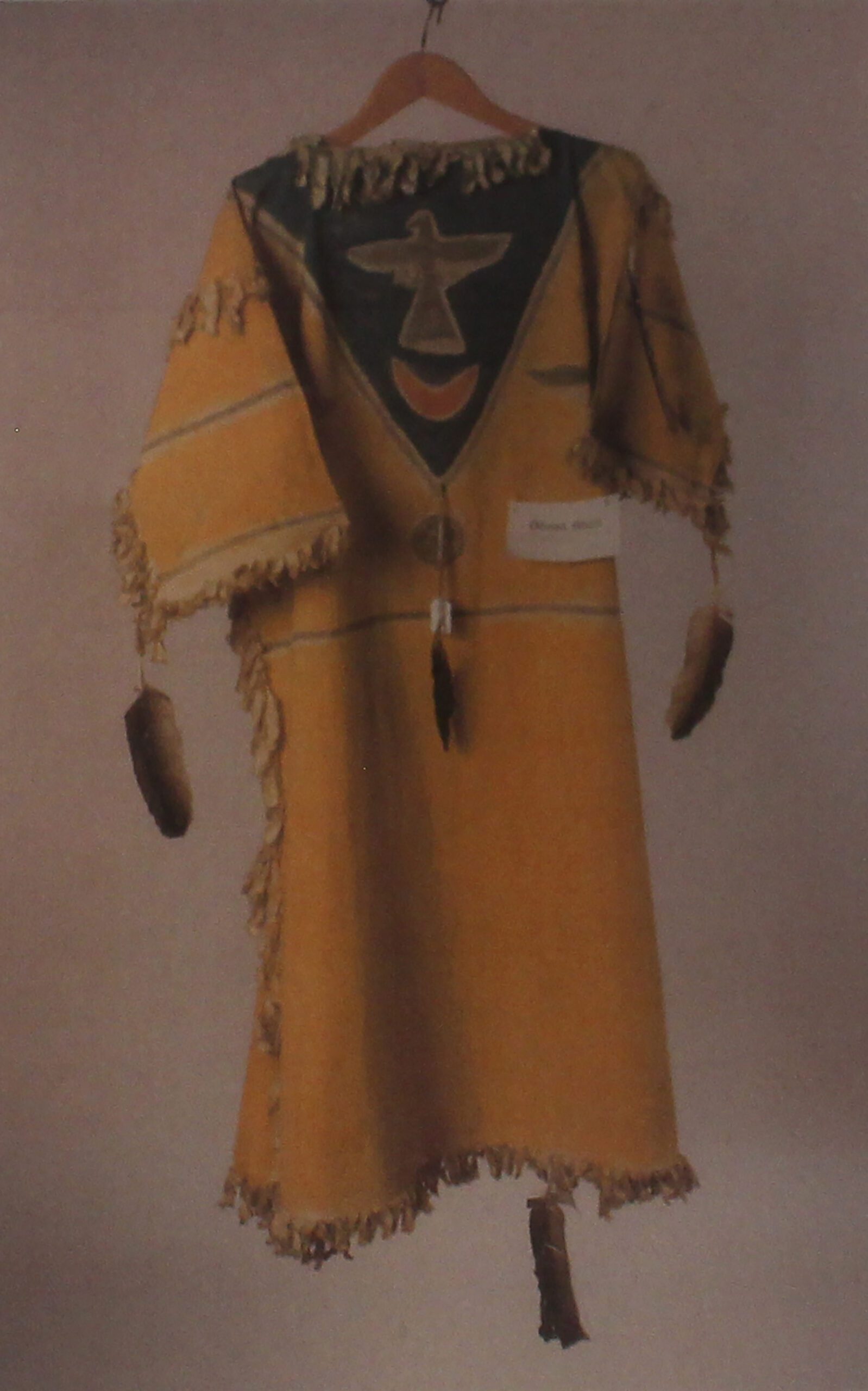
A Ghost Dance Shirt that is part of the collection of items that were returned to the Oceti Sakonwin. (Photo courtesy of Wounded Knee Survivors Associations)
PORCUPINE – On Thursday December 29, on the anniversary of the massacre at Čhaŋkpé Ópi Wakpála (Wounded Knee Creek) sacred Lakota and Dakota artifacts, some of which were stolen from the massacre site, where transported from the Oglala Lakota College Museum to the gravesite.
Each year a group of riders called the Omaka Tokatakiya (Future Generations Riders) start out along the Grand River on the Standing Rock Indian Reservation, at the site where Tatanka Iyotaka (Sitting Bull) was killed in 1890, and begin their 300 mile trek to the massacre site.
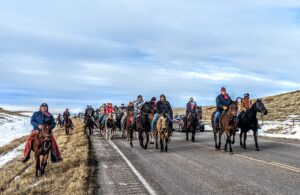
The Omaka Tokatakiya Riders (Future Generations Riders) as they finish the last stretch of their trek to the Wounded Knee Massacre site. (Photo by Thomas Whillock)
This year when the riders arrived, they had the privilege of participating in a sacred ceremony in which the Lakota and Dakota artifacts returned from a small Massachusetts museum were present.
The newly elected President of the Oglala Sioux Tribe, Frank Star Comes Out, sent an invitation to the Si Tanka Ta Oyate (descendants of the Spotted Elk band also known as Big Foot) announcing that artifacts from the 1890 Wounded Knee Massacre site would be transported from Oglala Lakota College to the Wounded Knee gravesite.
On the morning of December 29, when the Omaka Tokatakiya Riders arrived at the grave site, a prayer ceremony took place with the artifacts which was conducted by Richard Broken Nose, Richard Moves Camp and Ivan Looking Horse.
After the prayer ceremony at the grave site the items were transported to Pahin Sinte Owayawa (Porcupine School Gym). After the items arrived another prayer ceremony took place. Present for the ceremony were both Frank Star Comes Out and the Chairman of the Cheyenne River Sioux Tribe, Ryman Lebeau.
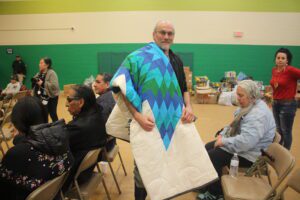
John Willis, Emeriti Professor of Marlboro College in Vermont was instrumental in the return of sacred artifacts to the Oceti Sakonwin. (Photo by Ernestine Anunkasan Hupa)
John Willis, Emeriti Professor of Marlboro College in Vermont, who said he had been coming out to South Dakota for 31 years, was instrumental in the return of the items.
Willis said he became involved in 2015 when he was teaching a class with Leonard Little Finger who had been going out to visit the Museum since the 80’s and 90’s. Little Finger was one of the people who fought to get the items returned to the Oceti Sakowin.
“He told me about the items. He asked myself and other people that were with me, this whole group of teachers and students, if we could go there and photograph the items and catalog a list of everything so the families and the tribes would know what we have and try and push them to give them back,” Willis said.
He said since 2015 he began visiting the museum several times a year, because he was living just over the border in Vermont. “I brought some Lakota youth there and at one point we had a cross cultural youth camp for many years in Eastern Vermont.”
Willis said the Founders Museum which is located in Barre, Massachusetts, was closed most of the year and only opened three or four afternoons a year for a few hours. In order to view the items one had to make an appointment. He said one was escorted into this big dark room with cluttered display cases where one often needed a flashlight to view the artifacts.
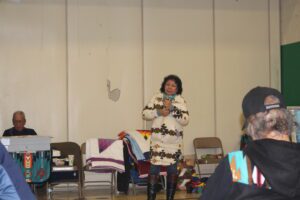
Donna Solomon shares the story of her grandmother who was a survivor of the Wounded Knee Massacre. (Photo by Ernestine Anunkasan Hupa)
“They never let anyone photograph any of the items and they always followed people around making sure no one stole any of the artifacts, or take notes or photograph any of them,” he said.
After a change in the museum board of directors, and with the help of Leola One Feather, a member of the Oglala Sioux Tribe, things began to move forward. Willis said John Wampanoag a member of the Mashpee Wampanoag tribe from Cape Cod was also instrumental in moving the process forward.
In November, a delegation from several Sioux Tribes traveled to Barre and helped transport approximately 150 items, some taken from the 1890 Wounded Knee Massacre site, back to the Oceti Sakowin. Many of the sacred artifacts had been part of the Frank Root collection housed at the Founders Museum for over a century.
Frank Root, a traveling 19th century salesman, acquired the artifacts to exhibit in a traveling road show. Some items are thought to have been stolen from the 1890 Wounded Knee Massacre site where about 300 Mnicoujou and Hunkpapa Lakota men, women, and children were brutally murdered by U.S. 7th Cavalry.
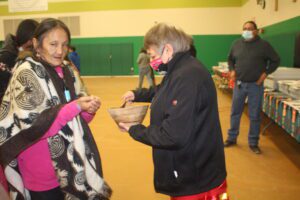
Marlys Afraid of Hawk, descendant of a Wounded Knee Massacre survivor serves the Oyate Wasna. (Photo by Ernestine Anunkasan Hupa)
The artifacts were transported from Barre, Massachusetts to the Oglala Lakota College Museum where they will be stored until ownership of the items can be determined. While many of the items were from the Wounded Knee Massacre site, many other items are from different time periods and different Sioux Tribes. Some of the items are from the Dakota Oyate with their signature floral design patterns.
Because the Founders Museum is a private institution that does not receive federal funding it was not subject to the Native American Graves Protection and Repatriation Act (NAGPRA). But Museum officials who had been working with tribes for more than 30 years believed returning the items was the right thing to do.
“It was always important to me to give them back,” said Ann Meilus, president of the board at the Founders Museum. “I think the museum will be remembered for being on the right side of history for returning these items.”
Oglala Sioux Tribe Fifth Member Justin Pourier who was a part of the delegation that returned the items to Oceti Sakowin land said that once the items return to South Dakota, they will be stored at the Oglala Lakota College as they work with descendants to decide what happens next.
Boxes containing the artifacts with pictures of their content were on display at Pahin Sinte, but not the actual artifacts themselves.
(Contact Ernestine Anunkasan Hupa at staffwriter@nativesunnews.today)
The post Sacred artifacts transported to massacre site first appeared on Native Sun News Today.
